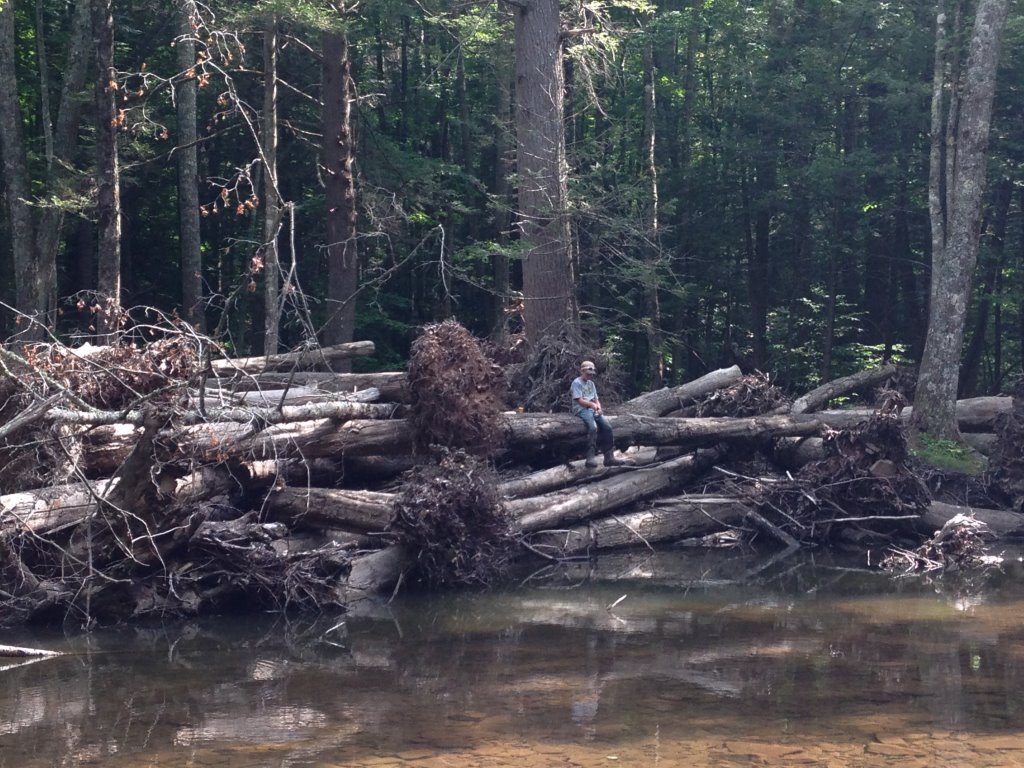Large wood additions on the East Fork of the Greenbrier River in West Virginia provide important habitat for brook trout — and a fishing location for a young angler.
By Gary Berti
In West Virginia, partnerships are critical as Trout Unlimited works on habitat restoration programs in the Potomac and Greenbrier River watersheds.
Recently, because of TU’s great work, TU had the honor of being invited to speak at the National Forest Foundation’s Collaborative Restoration Workshop in Colorado, attended by over 300 restoration professionals from across the country, including the leadership of the U.S. Forest Service and the Department of Agriculture.
I was pleased that, after the conference, Dan Shively, the USFS National Fisheries Program Manager, took time to pass along to TU CEO Chris Wood some positive words regarding TU’s work in WV, writing in an email: “Gary did an outstanding job providing an overview of high priority restoration work for eastern brook trout in West Virginia, highlighting the value of the Forest Service-TU partnership,”
Let it be known that TU’s work in the area would not happen without the support and guidance of the USFS at all levels.
As Director of TU’s Eastern Home River Initiatives, I help implement TU’s mission to build bridges with the agencies and organizations that share our vision of clean, healthy streams which support robust, sustainable fisheries. The breadth of our Eastern Conservation relationship with the U.S. Forest Service spans our entire range: from Georgia, to Northern New England, and westward throughout the Great Lakes Region. The Forest Service, with its 300 or so Fisheries Biologists, and TU, with its mission to restore and reconnect habitat, make natural partners to put aquatic restoration to work.
One of TU’s best examples of how we work together is the work accomplished under the recent Two Chiefs Program — Chief of the Forest Service and Chief of the Natural Resources Conservation Service — in West Virginia.
The program was named the West Virginia Restoration Venture (the “WV RV: a Vehicle to the Future!” was the tagline, bringing up some keen, off-subject, visions in my own mind…think hunting camps, moonshine, and stovepipes).
But this partnership was more serious than my mind’s eye would have you believe: WVRV brought together the staff and line officers of the Monongahela National Forest and the leadership of the West Virginia NRCS, along with multiple non-profits, state agencies, and TU volunteers.
The work wasn’t without its difficulties, but we accomplished a lot of private and public works. Some of the highlights include:
•TU installed 15 large wood engineered structures to create pool, cover, and low flow refugia habitat, and to perform a ‘proof of concept’ for the effectiveness of this approach. Subsequent surveys have been 100 percent positive.
•TU reconnected more than 30 miles of native trout habitat by removing barriers on both public and private lands, with many more passable miles under contract for 2016 and beyond.
•TU crews, with direction by USFS, has installed more than 20 miles of in-stream habitat work on native trout streams to increase habitat value, and thermal resilience during low flow conditions, and to clean and sort substrate to enhance spawning, rearing and food source production zones.
•On USFS lands, TU restored 20 miles of riparian forest with native plantings, while TU planted more than 20 acres on private lands.
•TU removed almost 20 miles of obsolete logging roads, to restore forest hydrology and keep ground water in the ground for as long as possible.
•Installed a state-of-the-art demonstration project on USFS lands at Seneca Rocks Visitors Center, which led to seven additional, consecutive private lands contracts in the watershed for similar work.
•TU and the USFS presented two national caliber workshops: one for the installation of large wood and one for the Stream Simulation methodology applied to road crossings, the sum of which trained more than 150 stream restoration professionals in better stream/trout habitat techniques.
•In essence, TU and the USFS has completed ‘Priority 1″ Aquatic restoration of the highest ranked watershed in the Monongahela National Forest, and will have completed the work in three years, and, in doing so, becomes the first in the nation to do so.
This work has gained exposure from the conservation community, but credit goes to our own TU leadership and to the great job done to tee up our work in the field. It is good to hear the high esteem the leaders of the Department of Agriculture have for our TU leadership team. This respect shines light on the whole of TU, and wearing the TU badge was an entrée to conversations that would not have otherwise occurred, the type of conversations that lead to building trust, and performing even more meaningful conservation in partnership with the like minded.
Gary Berti is the director of Trout Unlimited’s Eastern Home Rivers Initiative programs.



